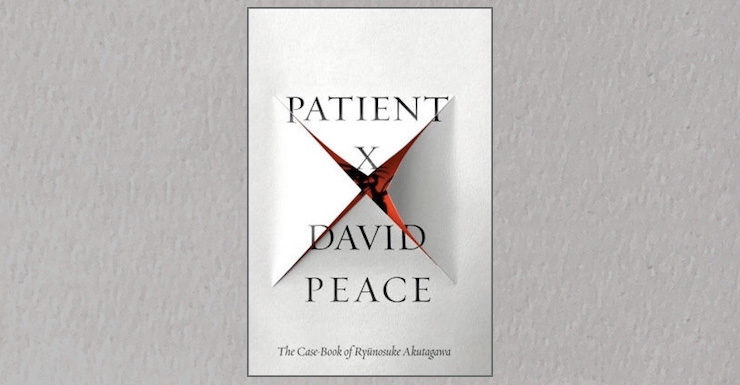David Peace’s literary career began with the Red Riding Quartet: four literary novels set in a specific period of time and a specific place, with a stylized and haunted prose approach that signified a penchant for the works of James Ellroy. In the years since then, Peace’s fiction has expanded in scope: he’s continued to tell crime stories, but he’s also brought his approach to fiction to bear on a number of different projects.
Chief among them are his pair of novels about soccer, The Damned United and Red or Dead. In these books, especially the latter, Peace uses language and structure to echo the rhythms and nuances of the game at the heart of the real-life subjects of the novels. It’s an unconventional approach to storytelling, but it’s one that fits its subjects well. All of which is to say that Peace’s latest novel, Patient X: The Case-Book of Ryūnosuke Akutagawa, echoes his novels about soccer, even as it’s nothing like them at all.
Ryūnosuke Akutagawa is likely best-known in the United States for his short story “In a Bamboo Grove,” which inspired Akira Kurosawa’s classic film Rashōmon. (Akutagawa also wrote a story titled “Rashōmon,” but it bears little resemblance to said film.) But his fiction was wide-ranging in its scope: sometimes historical, sometimes metaphysical, sometimes brutally autobiographical, and often incorporating elements of the supernatural. And so, in telling the story of Akutagawa’s tormented life, Peace has opted to do so in a literary manner that pays homage to Akutagawa’s bibliography, and in doing so journeys to several surreal and fantastical places, all the while remaining grounded in the literary and the tragic.
Full disclosure: I’m not sure what a reader who knows nothing about Akutagawa would make of this book. (Peace does provide suggestions for further reading once his narrative concludes.) Before reading Patient X, I spent some time with the collection Rashōmon and 17 Other Stories, which comes with a comprehensive introduction to Akutagawa and his influence on Japanese literature by none other than Haruki Murakami. Coincidentally, I’d also just finished reading Black and White, a surreal metafictional crime story by Akutagawa’s contemporary Jun’ichirō Tanizaki. In her afterword, translator Phyllis I. Lyons discusses the theory that Tanizaki wrote the novel to make his case in a heated debate he and Akutagawa had had shortly before the latter’s death—and that the characters can be seen as representatives of each author’s respective approaches to fiction.
“Akutagawa successfully imported his propensity for modernism into a fictional world in the borrowed container of the folktale,” Murakami writes in his introduction to Rashōmon and 17 Other Stories. Akutagawa was born in 1892; he wrote during a time when Japan was becoming increasingly connected to the rest of the globe, and the tension between tradition and Western influences is a recurring theme in his work. (That this novel is written by a man born in Yorkshire who now calls Tokyo home makes for an interesting wrinkle on things.) It’s worth mentioning, too, that like the protagonists of Peace’s soccer novels, Brian Clough and Bill Shankly, Ryūnosuke Akutagawa had a fondness for socialism; one of the people to whom Peace’s novel is dedicated is the late Mark Fisher, another politically-minded writer who left this world far too soon.
Buy the Book


Patient X: The Case-Book of Ryunosuke Akutagawa
Patient X: The Case-Book of Ryūnosuke Akutagawa is told through a series of twelve relatively self-contained narratives, each utilizing a different style. Some echo Peace’s past work, with a frenetic approach to language and an unorthodox structure. Others are more direct homages to Akutagawa: the opener, “After the Thread, Before the Thread,” about an attempt to rescue Akutagawa from hell, is an extended riff on Akutagawa’s own story “The Spider Thread.” Because this is a book about a man in the midst of a spiritual crisis—Akutagawa took his own life when he was 35—the supernatural and metaphysical become a very realistic aspect of the novel.
“He believed in ghosts and spirits, the mythical beings and creatures of folklore,” Peace writes late in Patient X. Perhaps the most significant example of this are the presence of kappa, a creature from Japanese folklore, as a recurring motif in Peace’s novel. One of Akutagawa’s best-known works—and one of the books that Peace recommends in particular—is his 1927 novel Kappa, about a visitor to a nation comprised entirely of the creatures. are a recurring presence in the narrative.
Late in the novel, Peace notes a 1959 edition of Kappa that was published in Argentina. The foreword to that edition was by none other than Jorge Luis Borges. Like Borges, Akutagawa’s fiction isn’t easy to pin down; instead, it emerges like something gleaming and multifaceted, impossible to directly categorize. With Patient X, Peace has distilled a life’s work into a moving tribute, one that offers up the visionary aspects of Akutagawa’s bibliography, but never loses sight of the anguished soul behind them.
Patient X is available from Knopf.
 Tobias Carroll is the managing editor of Vol.1 Brooklyn. He is the author of the short story collection Transitory (Civil Coping Mechanisms) and the novel Reel (Rare Bird Books).
Tobias Carroll is the managing editor of Vol.1 Brooklyn. He is the author of the short story collection Transitory (Civil Coping Mechanisms) and the novel Reel (Rare Bird Books).










